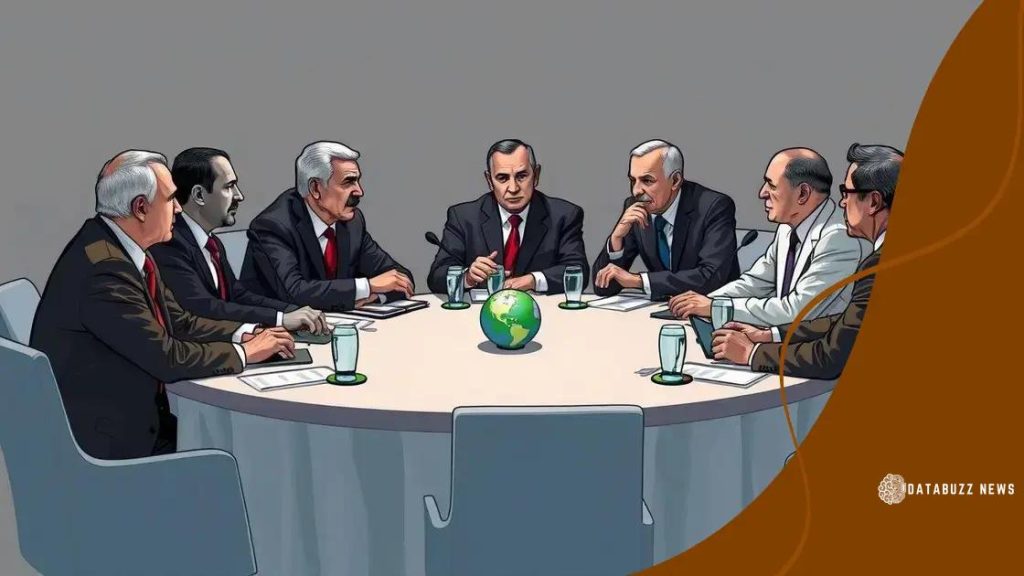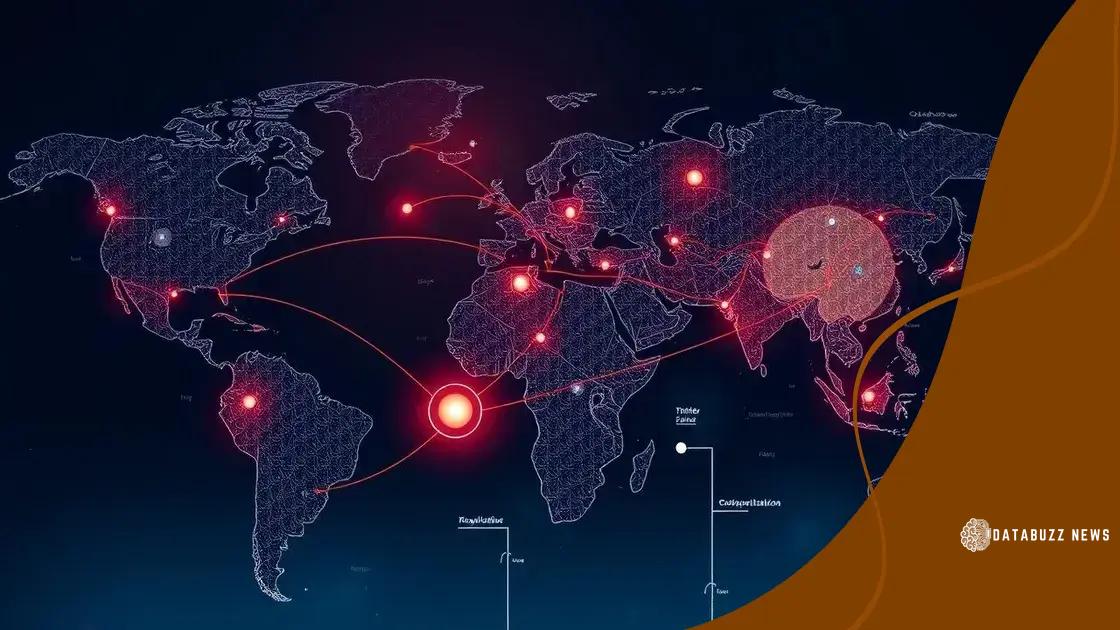Shifts in international relations policies: understanding the changes

Shifts in international relations policies are driven by globalization, technological advancements, the rise of emerging economies, and increasing multilateral cooperation, necessitating countries to adapt their diplomatic strategies accordingly.
Shifts in international relations policies are happening at a rapid pace, influencing global dynamics in ways we might not fully appreciate yet. Have you considered how these shifts could impact your daily life and the world around you? Let’s explore what’s changing and why it matters.
Understanding the historical context of international relations
Understanding the historical context of international relations is essential for grasping current global dynamics. Many events have shaped our diplomatic landscape over the years. From World War II to the Cold War, each period introduces unique lessons and changes.
The Cold War’s Influence
The Cold War is a critical chapter in international relations. It was characterized by ideological battles between capitalism and communism. Tensions between superpowers defined international diplomacy.
- Military alliances formed, such as NATO and the Warsaw Pact.
- Proxy wars occurred in various regions, showcasing indirect conflicts.
- Espionage and intelligence played a major role.
As we moved past the Cold War, globalization transformed relations. Countries began cooperating more for economic prosperity. Trade agreements emerged, leading to a new era of interdependence.
Post-World War II Developments
After World War II, the establishment of the United Nations aimed to promote peace. This was a significant step toward preventing future conflicts. The foundation focused on diplomacy and collective security, influencing international policy.
Another essential factor was the rise of non-state actors. Organizations like NGOs and multinational corporations began participating in international relations.
With the fall of the Soviet Union, we saw further shifts. Countries in Eastern Europe transitioned toward democracy. This upheaval showcased the importance of understanding local histories and contexts when analyzing international relations today.
In summary, analyzing the historical context of international relations helps us appreciate the complexities of today’s global stage. The lessons from the past continue to inform diplomatic strategies and policy decisions around the world.
Key factors driving policy shifts
Several key factors are driving shifts in international relations policies today. Understanding these influences can provide insights into how global dynamics are changing. One major driver is the rise of globalization. As countries become more interconnected, economic ties grow stronger, leading to cooperative policies.
Technological Advances
Technology plays a significant role in shaping international policies. The advent of the internet and communication technologies has transformed diplomatic engagement. It’s easier for countries to share information and collaborate on global issues.
- Real-time communication enables swift responses to crises.
- Social media influences public opinion and policy decisions.
- Development of cybersecurity measures affects national security policies.
Additionally, shifting power dynamics are crucial. Emerging economies are gaining influence, challenging established powers. This change is not merely about economic growth but also about political power and negotiation strategies. Nations like China and India are reshaping trade relations and geopolitical alliances.
Climate Change Concerns
Climate change is another key factor driving policy shifts. As the effects of climate change become more evident, countries are forced to adapt their foreign policies to address environmental issues. This shift includes:
- Collaborative international agreements on carbon emissions.
- Investments in renewable energy technology and infrastructure.
- Fostering partnerships for sustainable development.
Public opinion also impacts policy-making. Citizens increasingly demand action on various issues, from social justice to environmental sustainability. Policymakers must respond to these demands to maintain legitimacy and public support.
In conclusion, understanding the key factors driving policy shifts offers clarity on how international relations evolve. Technological advancements, emerging global economies, climate change, and public opinion are reshaping the landscape and shaping future diplomatic strategies.
Impact of globalization on international relations

The impact of globalization on international relations is profound, influencing how countries interact with one another. As borders become less significant, nations find themselves increasingly dependent on each other. This interdependence brings both opportunities and challenges.
Evolving Economic Ties
One significant aspect is the evolution of economic ties. Globalization has facilitated trade and investment around the world. Countries can now access a broader market for their goods and services, enhancing economic growth.
- Trade agreements, such as NAFTA and the EU, illustrate this shift.
- Countries are incentivized to cooperate economically to boost their prosperity.
- Foreign direct investment (FDI) has surged due to globalization, providing new job opportunities.
However, economic dependencies can lead to vulnerabilities. When one country faces a crisis, it can impact others. This was evident during the 2008 financial crisis, which spread globally, demonstrating how interconnected economies are.
Cultural Exchange and Influence
Globalization also fosters cultural exchange and influence among nations. People worldwide can share ideas, traditions, and values, creating a more interconnected world. This cultural mingling allows for greater understanding but can also lead to friction when local cultures feel threatened.
Moreover, global challenges, such as climate change and health pandemics, require collaborative responses. Countries are recognizing that many problems transcend borders, demanding a unified approach. This cooperation often results in international treaties and agreements aimed at mutual benefit.
In this new landscape, the role of multinational organizations has grown. They help facilitate dialogue and partnerships among countries. The United Nations, for example, plays a crucial role in promoting global security and development by addressing international issues collaboratively.
The impact of globalization on international relations is an ongoing evolution. As countries navigate this complex network of interdependence, understanding these dynamics becomes increasingly vital for successful diplomacy and international strategy.
Major players in current international diplomacy
In the realm of international diplomacy, several major players shape global interactions. Understanding their roles is essential for grasping how international relations are formed and executed.
United States
The United States remains a dominant force in global diplomacy. Its military and economic power allow it to influence many countries. The U.S. leads initiatives on various issues, from trade agreements to security pacts. Major policies from the U.S. can lead to shifts in alliances and global trends.
China
China has rapidly become a critical player, with its growing economic power and global influence. The Belt and Road Initiative exemplifies China’s strategy to enhance its presence worldwide by investing in infrastructure projects across countries. This initiative shows how China is not only a player in trade but also in global development.
- China aims to extend its influence across Asia, Africa, and Europe.
- Its engagement in international organizations has increased.
- China often challenges U.S.-led policies, leading to a new balance of power.
Another key player is the European Union (EU), which operates as a unified front on many diplomatic fronts. The EU emphasizes collective decision-making among member nations, impacting trade agreements and environmental policies. Its ability to wield collective economic power makes it a significant force on the world stage.
Russia
Russia’s role in international diplomacy cannot be dismissed either. Its strategic military capabilities and energy resources allow it to exert influence over Europe and Central Asia. However, Russia’s approach can often lead to tensions with Western nations, especially concerning issues like Ukraine and Syria.
In addition to these nations, non-state actors and international organizations play an essential role in diplomacy too. Groups such as the United Nations and various non-governmental organizations (NGOs) strive to address global issues like humanitarian crises and climate change.
Understanding the dynamics between these major players provides insight into current international relations. Each player brings unique strategies and priorities, shaping how countries interact globally.
Forecasting future trends in global relations
Forecasting future trends in global relations requires understanding current patterns and historical contexts. Recent developments suggest several key areas where change is likely to occur. As the world continues to evolve, the importance of diplomatic strategies and alliances will grow.
Increased Multilateralism
The future of international relations may see a rise in multilateralism. Countries are beginning to realize that global challenges, such as climate change and pandemics, require collective action. This shift encourages nations to work together rather than acting unilaterally.
- Expect more international agreements addressing environmental concerns.
- Trade policies will increasingly focus on sustainability.
- Collaborative security efforts will emerge to manage global threats.
As nations collaborate more, dialogue and cooperation will be essential in shaping foreign policies. Other countries will need to adapt their strategies to accommodate this new emphasis on teamwork.
Technological Advancements
Technology will play a crucial role in shaping future global relations. Innovations in communication and information sharing can enhance diplomatic efforts. Additionally, technology can drive economic changes, fostering new partnerships while increasing competition.
Emerging technologies, such as artificial intelligence and blockchain, are expected to influence diplomatic relationships. Nations must keep up with these advancements to avoid falling behind.
Shifting Economic Powers
The global balance of economic power is also shifting. As emerging economies like India and Brazil continue to grow, they will become more significant players in global affairs. These nations may demand a greater voice in international organizations, further changing how diplomacy functions on the world stage.
Furthermore, older power structures may need to adapt or face challenges from these rising economies. As such, established powers will have to reassess their positions in light of these changing dynamics.
In summary, forecasting future trends in global relations shows a path of increased collaboration, the influence of technology, and the rise of new economic powers. Navigating these trends will be essential for countries aiming to maintain relevance in an ever-changing world.
FAQ – Frequently Asked Questions about International Relations Policies
What is globalization’s impact on international relations?
Globalization increases interdependence among nations, leading to more collaborative diplomatic efforts and shared economic ties.
How do technological advancements influence diplomacy?
Technological advancements enhance communication and information sharing, making diplomatic efforts more effective and streamlined.
Who are the major players in current international diplomacy?
The major players include the United States, China, the European Union, and Russia, each playing a significant role in shaping global relations.
What trends should countries watch in future global relations?
Countries should monitor increasing multilateralism, the rise of emerging economies, and the impact of technology on diplomatic strategies.
